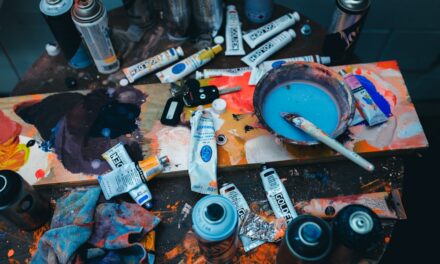Abstract watercolor painting is a captivating realm where the fluidity of water and pigment intertwines to create emotive and evocative works of art. Unlike traditional representational art, abstract watercolor allows artists to explore their innermost feelings and thoughts, translating them into visual forms that may not adhere to the constraints of reality. This form of expression invites spontaneity and experimentation, encouraging artists to embrace the unpredictable nature of watercolour as a medium.
The beauty of abstract watercolour lies in its ability to convey mood and atmosphere through colour, shape, and texture, rather than through recognisable subjects. As artists delve into abstract watercolour techniques, they often find themselves liberated from the pressures of perfectionism. The inherent unpredictability of watercolour can lead to serendipitous discoveries, where accidental drips and washes become integral components of the artwork.
This freedom fosters a unique dialogue between the artist and the medium, allowing for a more intuitive approach to creation. In this article, we will explore various aspects of abstract watercolour painting, from understanding colour theory to experimenting with different application methods, all aimed at enhancing one’s artistic journey in this vibrant genre.
Summary
- Abstract watercolor techniques allow for freedom of expression and creativity in painting.
- Understanding color theory is essential for creating harmonious and visually appealing watercolor paintings.
- Freeform art in watercolor encourages artists to explore their emotions and express themselves without constraints.
- Creating texture and depth in abstract watercolor can be achieved through various techniques such as salt, splattering, and lifting.
- Experimenting with different watercolor application methods, such as wet-on-wet and wet-on-dry, can result in unique and interesting effects in paintings.
- Masking fluid and resist techniques can be used to preserve areas of the paper and create interesting contrasts in abstract watercolor art.
- Mixed media and collage can add depth and interest to abstract watercolor paintings, allowing for a combination of different materials and textures.
- Tips for creating vibrant and dynamic abstract watercolor paintings include using bold colors, varying brushstrokes, and embracing spontaneity in the creative process.
Understanding Color Theory in Watercolor Painting
Understanding the Colour Wheel
The colour wheel serves as a fundamental tool for artists, illustrating the relationships between primary, secondary, and tertiary colours. By mastering these relationships, artists can create harmonious compositions that resonate with viewers on an emotional level.
The Emotional Impact of Warm and Cool Colours
Warm colours such as reds, oranges, and yellows tend to evoke feelings of energy and warmth, while cool colours like blues and greens can instil a sense of calm and tranquillity. By strategically combining these colours, artists can manipulate the emotional response elicited by their work.
Creating Contrast and Depth
Additionally, the use of complementary colours—those opposite each other on the colour wheel—can create striking contrasts that draw the viewer’s eye and add depth to the composition. Thus, a firm grasp of colour theory not only enhances an artist’s technical skills but also enriches their ability to convey meaning through their abstract watercolour creations.
Exploring Freeform Art and Expression in Watercolor
Freeform art is a celebration of spontaneity and personal expression, allowing artists to break free from conventional constraints. In abstract watercolour painting, this approach encourages individuals to explore their emotions and thoughts without the need for a predetermined outcome. The fluid nature of watercolour lends itself beautifully to this style, as artists can let go of rigid structures and embrace the organic flow of paint on paper.
This freedom often leads to unexpected results that can be both exhilarating and enlightening. Incorporating freeform techniques into abstract watercolour can involve various methods, such as pouring, splattering, or using unconventional tools like sponges or brushes with varying bristle lengths. These techniques invite chance into the creative process, allowing for unique textures and patterns to emerge.
Artists may find themselves drawn to certain shapes or colours that resonate with their current state of mind, leading to a more personal connection with their work. Ultimately, freeform art in abstract watercolour serves as a powerful means of self-discovery, enabling artists to communicate their innermost thoughts and feelings through visual language.
Techniques for Creating Texture and Depth in Abstract Watercolor
Texture plays a pivotal role in enhancing the visual interest of abstract watercolour paintings. By employing various techniques, artists can create layers that add depth and complexity to their work. One effective method is the use of wet-on-wet techniques, where wet paint is applied onto a wet surface.
This allows colours to blend seamlessly, creating soft edges and ethereal effects that evoke a sense of movement. Conversely, wet-on-dry techniques involve applying wet paint onto a dry surface, resulting in sharper edges and more defined shapes. Another way to introduce texture is through the use of salt or alcohol on wet paint.
When sprinkled onto a wet wash, salt absorbs moisture and creates unique crystalline patterns as it dries. Similarly, applying alcohol can produce interesting effects by repelling the paint and creating lighter areas within the composition. Additionally, layering different washes can build up texture over time; by allowing each layer to dry before adding another, artists can create rich surfaces that invite viewers to explore the intricacies of the piece.
These techniques not only enhance the visual appeal but also contribute to the overall narrative conveyed through the artwork.
Experimenting with Different Watercolor Application Methods
The versatility of watercolour allows for a myriad of application methods that can transform an artist’s approach to abstract painting. Traditional brushwork is just one avenue; artists can also explore techniques such as pouring, spraying, or even using unconventional tools like sponges or palette knives. Pouring involves tilting the paper and allowing paint mixed with water to flow freely across the surface, creating organic shapes and patterns that are often unpredictable yet captivating.
Spraying watercolour with a spray bottle or using an airbrush can yield soft gradients and delicate textures that are difficult to achieve with brushes alone. This method allows for greater control over how much pigment is applied while also introducing an element of chance as colours blend together in unexpected ways. Additionally, using sponges can create unique textures by dabbing or stippling paint onto the surface, resulting in a more tactile quality that invites viewers to engage with the artwork on multiple levels.
By experimenting with these diverse application methods, artists can discover new ways to express their creativity and push the boundaries of traditional watercolour techniques.
Using Masking Fluid and Other Resist Techniques in Abstract Watercolor
Preserving Delicate Areas
This liquid latex substance can be applied to paper before painting; once dry, it acts as a barrier that prevents paint from adhering to those areas. This technique enables artists to create intricate designs or maintain highlights within their compositions without fear of losing them during subsequent layers.
Exploring Resist Techniques
In addition to masking fluid, other resist techniques can further enhance an abstract watercolour piece. For instance, using wax crayons or oil pastels can create interesting contrasts when painted over with watercolour; the wax resists the paint, resulting in striking lines or shapes that stand out against the background. Similarly, using tape to create sharp edges or geometric shapes can add structure to an otherwise fluid composition.
Encouraging Creative Expression
These resist techniques not only provide opportunities for creative expression but also encourage artists to think outside the box when it comes to their approach to abstract watercolour painting.
Incorporating Mixed Media and Collage into Abstract Watercolor Art
The integration of mixed media into abstract watercolour art opens up a world of possibilities for creative exploration. By combining various materials such as paper scraps, fabric, or even found objects with traditional watercolour techniques, artists can add layers of meaning and texture to their work. Collage elements can serve as focal points or background textures that enhance the overall composition while providing visual contrast against fluid washes.
Incorporating mixed media also allows for greater narrative depth within abstract pieces. For instance, an artist might use newspaper clippings or photographs alongside watercolour washes to convey themes related to memory or identity. The juxtaposition of different materials invites viewers to engage with the artwork on multiple levels, encouraging them to interpret its meaning through their own experiences.
As artists experiment with mixed media techniques in their abstract watercolour practice, they often discover new avenues for self-expression that transcend traditional boundaries.
Tips for Creating Vibrant and Dynamic Abstract Watercolor Paintings
Creating vibrant and dynamic abstract watercolour paintings requires both technical skill and an adventurous spirit. One essential tip is to embrace bold colour choices; using saturated hues can infuse energy into a piece while capturing the viewer’s attention.
Additionally, layering is key in achieving depth and complexity within abstract watercolour paintings. By building up washes gradually and allowing each layer to dry before adding more pigment, artists can create rich textures that invite viewers to explore every inch of the canvas. Furthermore, incorporating negative space—areas left unpainted—can enhance composition by providing balance and contrast against vibrant colours.
Ultimately, creating dynamic abstract watercolour art is about embracing experimentation while honing one’s skills; it is through this journey that artists find their unique voice within this expressive medium. In conclusion, abstract watercolour painting offers a rich tapestry of techniques and approaches for artists seeking to express themselves creatively.
By embracing spontaneity and allowing for serendipitous discoveries along the way, artists can unlock new dimensions within their work while forging deeper connections with their audience through vibrant and emotive compositions.
If you are interested in exploring different painting techniques, you may also enjoy reading about the alla prima technique of wet-on-wet oil painting. This article delves into the process of creating dynamic and expressive oil paintings using this traditional method. By learning about different painting techniques, such as abstract watercolor and alla prima, artists can expand their creative repertoire and develop their own unique style.


